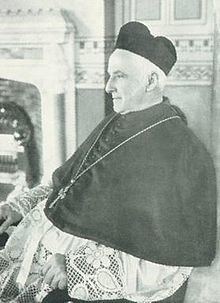Term ended 1927 Ordination 1880 (Priesthood) | Installed 1924 Created Cardinal 14 December 1925 Died 22 October 1927, Armagh Consecration 25 March 1888 | |
 | ||
Place of burial St Patrick's Cathedral, Armagh | ||
Patrick Joseph O'Donnell (28 November 1856 – 22 November 1927) was an Irish Cardinal of the Roman Catholic Church. He served as Archbishop of Armagh from 1924 until his death, and was elevated to the cardinalate in 1925.
Contents
Early life
Patrick Joseph O'Donnell was born in Glenties, County Donegal in 1856, son of Daniel O'Donnell, a farmer, and his wife, Mary (née Breslin). He was one of nine children in a family that claimed descent from the O'Donnells of Tyrconnell. He was ordained a priest on 29 June 1880, He was educated in the High School, Letterkenny, the Catholic University, Dublin (1873-'75) and St Patrick's College, Maynooth. He was ordained to the priesthood on 29 June 1880. In that same year he was appointed to the staff of St Patrick's College, Maynooth, holding the chairs of Dogmatic and Moral Theology. In 1884 he became dean of the revived post-graduate Dunboyne Institute and in 1885 was awarded his STD. From his desk in Maynooth he poured out a continuous stream of articles on moral theology and canon law.
Church leadership
He became Bishop of Raphoe on 26 February 1888. When he was the youngest in the world at the time and was consecrated by Cardinal Logue on 3 April in Letterkenny. With superior qualities of mind and body, he was a benign figure who was yet gifted with sharp political acumen. He had the most distinguished episcopate, locally and nationally. He undertook and completed prodigious building projects: a superbly-sited neo-gothic (with Romanesque details) cathedral, overlooked by a house for bishop and clergy (1891–1901); St Eunan’s Diocesan College (1906); the Presentation Monastery and Loreto schools and an extension to Loreto Convent, all in Letterkenny.
He was appointed coadjutor Archbishop of Armagh on 14 January 1922 and succeeded Cardinal Michael Logue on 19 November 1924. On 14 December 1925, Pope Pius XI made O'Donnell a Cardinal.
Activism
He took an active part in the social, political, and economic life of Ireland. A staunch activist for social justice, as Bishop of Raphoe, he was a member of the first Committee of the Irish Agricultural Organization Society, founded by Sir Horace Plunkett, and was referred to by Plunkett's close in-law cousin, Elizabeth, Countess of Fingall, in her memoirs in the following terms "Many people say that Dr. O’Donnell had the biggest brains of his Church, and even outside it, in Ireland". In 1918 when representing the nationalist's side at the Irish Convention, he opposed John Redmond's amendment intended to bring about unanimity on All-Ireland Home Rule.
O'Donnell motto
As a Cardinal, visiting the Holy See and the Apostolic Palace in the Vatican, he would have been seen the motto In Hoc Signo Vinces that was earlier adopted by the O'Donnell Earls of Tyrconnell in 1603-14. The motto appears prominently placed on the Scala Regia as a motto on a sculpted ribbon unfurled with a passion cross to its left, beneath a window overlooking St. Peter's Square. An armorial achievement with a cross on the shield and this motto were recorded during the reign of King James I by the Ulster King of Arms as those of Rory O'Donnell, 1st Earl of Tyrconnell, based on the earlier adoption of the cross and motto by the O'Donnell rulers, as described in the Lebhar Inghine i Dhomhnaill.
Final years
Cardinal O'Donnell died on 22 October 1927 in Carlingford, County Louth, Ireland.
The St. Connell's Museum in his home town of Glenties has a display about his life.
